Reflections on Educause 2010
A number of colleagues (and myself!) attended the Educause conference (which focuses on Information Technology and Higher Education) in Anaheim, CA, the week of October 12. I enjoy the opportunity to attend this conference when I can because I find that the sessions tend to be around the larger, strategic issues that higher education faces in an era of rapidly changing technologies and delivery paradigms. As I heard in a number of sessions in the conference – higher education is becoming unbundled, both in terms of software and delivery models, and we are going to have to be collaborative and inventive like never before in order to serve our students – because if we don’t serve them well, then someone else will! This year, the conference had around 6700 attendees, with 41 different countries represented, and additional sites attending online. Overall, I had an excellent conference experience and truly enjoyed it (thanks conference committee!).
Tuesday, October 12
I traveled to Anaheim with several colleagues from other areas across NC State, a journey that took most of the day (from my house, 8am to arrival at the hotel at around 5pm). Luckily, the trip was fairly uneventful (the way I like travel to be when planes are involved) – well, except for the replacement of some radar/GPS unit on our plane at Dallas Fort Worth that was apparently important for radio communications with the air traffic controllers (as good communication is a core value of mine, I didn’t mind the delay).
After settling in for a bit and grabbing a bite to eat (my colleagues know I am always hungry), I headed over to the opening reception in the Educause vendor exhibit area. The vendor exhibit area has as many blinking lights and moving objects as, say, Piccadilly Circus in London or Times Square in New York, and even a few individuals dressed “in-character” to try and direct your attention toward a particular product.
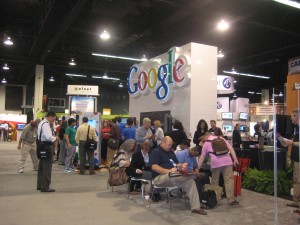
Once you get past the overwhelming visual disruption caused by all the blinking, moving components in the room, it is enlightening to walk around and get your hands on some of the new technologies on display, and talk to the vendors about what they are doing with their product roadmaps.
Of course, to me, the most important vendor on the floor was not trying to sell a product, but an idea. That vendor was our own Lisa Fiedor (DELTA), who was part of the Accessibility booth at Educause. She, along with a number of colleagues from other institutions, were using this opportunity to try and raise vendor awareness of accessibility and usability issues so that they will address accessibility in product design, rather than as an afterthought.
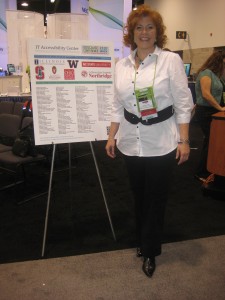
After saying hi to Lisa and others in the exhibition hall that I knew [including Marc Hoit, NC State’s CIO, Mardecia Bell (OIT), and Keith Boswell (Engineering)], myself, Bethany Smith (Education), Alan Schueler (CALS), and Greg Robinson (CNR), went to an evening event sponsored by TechSmith, the vendor that supports Camtasia and Camtasia Relay. Camtasia (by itself) is a tool that we teach/support in DELTA and use to create some of our Quick Trainings. What you may or may not know is that Camtasia Relay is a software solution that does classroom capture (screen/voice only – no video). The College of Natural Resources uses this product extensively to support lecture capture (for non-DE courses) and is happy with this product for their particular needs.
I had an engaging conversation with Bethany, Greg and Alan about the lecture capture space and the importance of ensuring that the colleges have affordable lecture capture solution options. As noted by the campus computing survey in a presentation at the conference, lecture capture is a technology now being seen as part of institutional strategy to deliver content, and as such, we need to be planning for it.
Tuesday evening wrapped up around 10pm Pacific Time, 1am Eastern Standard Time – way late for me!
Wednesday, October 13
Wednesday morning started early with a 7am breakfast, where I was joined by Lou Harrison (DELTA), and Bethany again. We then headed off to the Educause opening session, entitled Reinventing Management for a Networked World with speaker Gary Hamel. Definitely some interesting points from this session around how do you build an organization that can outrun change? The speaker provided lots of examples of disruptive change which allows individuals to go around a traditional structure (e.g. Skype, Zopa, Hulu, etc.), and some thoughts on how higher education may be affected by “specialization models” (e.g. global RFPs for best of the best course development, specialists instead of generalists).
In a world of accelerated change, this speaker said we should “cut our business loose from traditional moorings,” and be configurable, unbundle ourselves to make room for specialized service providers, and democratize strategic conversations. The problem, he said, is not the technology but the organization – that higher education is locked into old organizational models that are slow to change, and that we need to reinvent ourselves by challenging our fundamental assumptions by strategically taking an offensive mentality. We should get over living in the past (the way it always has been done), crowdsource our strategic planning so we have leadership from those who are experiencing the future first hand, and wake up every morning ready for the challenge because education is a higher calling and we have to have a sense of mission.
With my brain still reeling from the first session, I headed off to another morning session called Centralized vs. Decentralized: Choosing Sweet Spots in Efficient Central Services and Local Value-Add Services, where I happened to run into and sit with colleague Stan North Martin (OIT). The presenters were from the University of Michigan (40,000 students, 19 schools and colleges), one representing central Information Technology (IT), the other, a specific college. The two talked about decentralization as a strategy – making sure that local IT is flexible enough to meet the unique needs of the colleges, but recognizing that some things could be better centralized or more coordinated (e.g. email, phone, web, network – central IT – some colleges are still doing their own!) Their university has been working with a consulting partner – Accenture – and they have looked at IT expenditures, completed unit assessments, completed a central IT capacity assessment, and have developed a better understanding of who is doing what in IT. They conceptualized IT in layers, as follows:
- Public goods – IT services that can be used by all – defined by a governance group and everyone pays for it – like public schools
- Toll services – IT services that can be used by most
- Community – IT services that can be used by a segment of common users
- Unique – IT services used by one unit
Overall, these presenters noted that the sweet spot isn’t a spot, rather it is a process where you look at the value of a service and decide if you need to have your own unique instance, or if you can free your resources locally for more specialized needs by using centralized IT for services that are available for all.
What worries them as they move forward?
- Funding models – without the right funding model, progress will be limited –funding does not incentivize the right behavior
- Local IT is great at personal communication and engagement –don’t want to lose this
- Central IT has to get really good at sourcing (finding alternates outside of campus) –when something is a commodity in the marketplace, then we should source and get out of the business
- IT Offerings have to meet reasonable quality expectations – true for both central and unit offerings
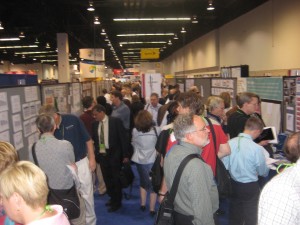
I then moved on to a late morning session called Community Source: Leading ourselves in the Era of the New Normal, which consisted of a panel of IT leaders (Marist College, University of Virginia, and Indiana University) in a Q&A type format regarding the role of open and community source in higher education. While the actual focus on tools was more in the area of ERP systems rather than learning technology systems, there were indeed takeaways. These leaders noted the value of open source, whether you use it or not, in allowing a sustainably diverse ecosystem of choice in the higher education market, and agreed that open source is good for the system even if we have chosen not to use it. There was some interesting conversation around the role of the CIO – that is, does the CIO co-shape and lead, or buy and react to? Working with the open source community, it was noted that we can participate in, and even lead, the process.
During lunch, myself, Alan and Bethany, as members of the NC State Digital Asset Management (DAM) Task Force currently looking at learning object/content repository solutions, chaired by Carolyn Argentati (Library) and Dan McWhorter (Vet School), met with Butch Porter and Jo Barrow from Equella. Butch and Jo have recently presented to the DAM Task Force meeting about their work with North Carolina’s Learning Object Repository. There is indeed interest on our campus for examining a content management system to organize collections, especially in places like the Vet School with large collections of images. Alan and Dan will be meeting soon to better define the needs in this area and discuss a possible pilot.
After lunch came one of my very favorite parts of any conference; that is, the poster sessions. These are usually very informative and provide you with the opportunity to converse at length with individuals about their project and/or research. There were a number of posters that caught my eye, including:
- Crowdsourcing the LMS (about using the students in the LMS to describe what the faculty are doing)
- Counting New Forms of Scholarship toward Tenure and Promotion (from the University of Minnesota)
- Evaluation Criteria for a Lecture Capture System (West Virginia University – picked up some good handouts for this one.
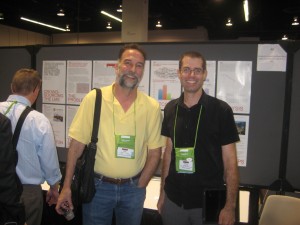
I also managed to catch up with an acquaintance that I usually see about every other year at conferences, Professor Susannah Quinsee from City University in London. Susannah was presenting a poster on Flexibility for Durability: Leadership Strategies for Turbulent Times. City University has also recently moved from Blackboard Vista to Moodle, so we exchanged some stories about our transitions.
After the afternoon poster sessions, I headed to another afternoon presentation called How the Availability of Streamed Lectures Modifies Undergraduate Student Behavior, presented by folks from the University of California at Los Angeles (UCLA). Not sure that I took away anything different then what I found in an earlier literature review of lecture capture. The speakers noted some arguments in favor of lecture capture, including fulfillment of student expectations, improving student learning (questionable – it depends on HOW it is used), pandemic planning, expanding classroom capacity, and the modification of pre-captured lectures into new forms of learning materials. UCLA has 200 classrooms that are podcast capable but the speaker noted that there is more demand as they are having to turn faculty away from these rooms – and he noted that once faculty have lecture capture available to them, they do not want it taken away. He also made the point that quality matters in lecture capture – and that providing the best quality as is possible with good production values is quite important.
Interviews with their faculty suggest that their faculty members are in favor lecture capture because:
- Students are better prepared for class
- There is more continuity from one lecture to another
- Better questions are asked during office hours
- It is easier to deal with student absences
- New uses for previously recorded lectures
In a student survey, students were asked what extent did having lectures online affect how often you come to class? While some percentage did indicate they are less likely, 65+% said it doesn’t affect their attendance as there are other factors (e.g. 8am class, not coming anyway). Interestingly, STEM students that responded to their survey indicated they were more likely to miss class and listen to the podcast. When the webcast is rich media, the tendency is for the students to prefer the webcast over a “live” lecture, with 95% of the students who responded to their survey indicating they felt podcasts helped their learning. In addition to the student surveys, they did some comparative studies with an Intro to Psychology Course (one section podcast, one live) where the podcast section did significantly better on the exam, and a Chemistry class, where there was no difference on the final exam for those who attended the e-lecture and those who attended regular class.
After wrapping up a long day of sessions, I went with several colleagues later that evening to downtown Disney for some events hosted by Dell and Moodlerooms. The big takeaway for the evening happened at the Moodlerooms event – not with the vendor, but with the other Universities that were there.
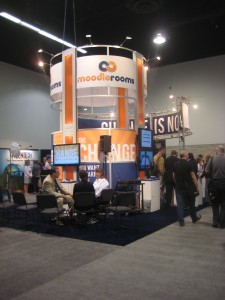
I had a number of people from different universities find out we were from NC State, and say “thanks so much for being so transparent with your Moodle selection process and your governance, we are using your stuff.” This was extremely gratifying to know that our work has made an impact beyond our university.
Thursday, October 14
Thursday morning started early again with another 7am breakfast, this time a meeting with Elluminate (NC State’s synchronous LMS provider), and Wimba, both now owned by Blackboard Collaborate. Specifically, myself, Martin Dulberg (DELTA) and Lou met with our local Elluminate representative Michelle Utset Valada (who has been our regional sales manager for some time and who has been the person I have contacted for a number of years now to help sponsor and support DELTA’s annual Summer Institute on Teaching and Learning with Technology), and several others (Anna Marie Ladd, Paul Roberge, and Kristian Photopoulos) to discuss our current positive relationship with Elluminate and our desire to ensure that they continue to provide us the quality support that our campus has been receiving during and after their transition into the Blackboard company. We heard at this meeting a continued commitment for quality support of this product, and received an assurance that Elluminate (and its next iteration) will continue to be a stand alone product that will work with whatever Learning Management System that we happen to be using.
Lou and I then attended an 8am session called Open-source strategies: Visionaries, Pragmatists, and Curmudgeons, a session that pulled together leaders from a larger university (Indiana State) and some smaller colleges/universities to talk about their perspectives on open source. While this particular session was more focused on ERP systems than LMS systems, the key takeaway that I got from this session was that if you believe in open source, then you need to believe in community participation, and when possible, you should be involved in and help shape the community with what you’d like to see happen. While we are still in early days with using Moodle, yet I am pleased to know that we’ve already had an impact in at least two ways; (1) with the actual code base, partnering with Remote Learner earlier this year to ensure some accessibility modifications were done that are now part of the code base for all in version 1.99 – raising some awareness of this issue for future iterations, and (2) knowing that other universities are referring to our LMS governance structure as a possible way to manage implementations.
I saw many (if not all) of my NC State colleagues at the morning feature session in the large arena called Distance vs. Distributed Education – Bringing the Campus to the Student. This session focused on the FabLab work from MIT, and during this presentation, we saw a number of examples of where these FabLabs (basically, digital fabrication laboratories that are community centers where the public can go to create things) have allowed creative individuals from all over the world to make amazing artifacts that do not require the invidividual to have an engineering or computational science background (which, if you see the outcomes, you would believe they would have to have). MIT takes the labs to the people, and then the creative work is simply unleashed.
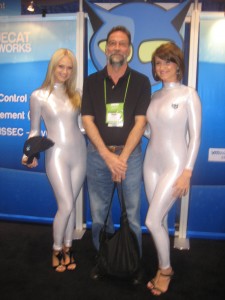
After these morning sessions, I went back to the vendor exhibition hall to take another look around, and to specifically find Chris Mann, from Learning Objects, to discuss the wikis and blogs (Campus Pack) that they support. Martin and I talked with Chris, and they have a wiki and blog solution that plugs nicely into Moodle, and it is an area that we are keeping an eye on. Of course, with Moodle 2.0 coming out soon, we definitely want to examine any updated wiki/blog solution within Moodle 2.0 prior to considering other, licensed options.
After a quick lunch with colleagues again (Lou, Alan, Bethany, Greg, Martin and Peter Watson – DELTA),
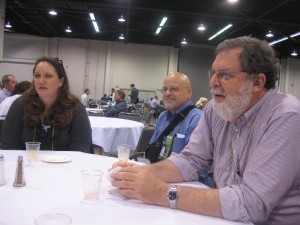
and another tour through the vendor exhibition hall, it was time for a lightning round of afternoon sessions.
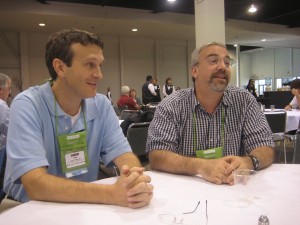
My first afternoon session of interest was called The Landscape is Changing Faster than you are: here’s why, with speakers from Ohio State and Harrison College. The main idea of this session was a discussion of the pressure on current educational models. More for-profit universities are appearing as these for-profits are nimble, quick and able to cater to specialized student needs. And traditional students? Well, according to this presentation, students over the age of 25 now comprise the majority of students in higher education, with more than 60 percent of all college students working full time now while they attend college. Kind of turns the profile of the traditional student on its head (and makes me think – okay, if 60% of college students are working full time then how do we expect them to complete their degrees, as they are currently offered, in four years??? ) . . . another interesting point from the presentation was the consideration of how to work with your alumni; for example, creating “just in time” programs/certificates that you can market to them that will immediately increase their job skills, thus enticing them back for retraining/continuing education at your university.
After that, on my way to the next session, I ran into Joanne Dehoney, who used to work in the Learning Technology side of DELTA a number of years ago – she went to Ohio State and is now at East Carolina. After catching up with her, I headed to another afternoon session called Is IT Governance an Oxymoron in Higher Education?, where I was joined by Alan and Stan North Martin (OIT).
Late afternoon, Alan, Greg, Bethany and Martin and I met in the speaker preparation room to prepare for our Friday presentation (Building Bridges: Using Moodle to Connect an Institution). We had a great time doing a final run-through of our presentation, and took a few pictures to commemorate our fun!
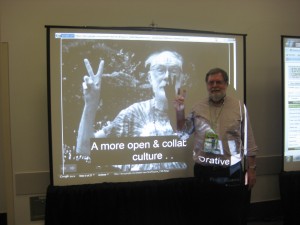
My final session for the day was a late afternoon discussion around Project Management – an Educause Birds of a Feather session, led by the Director of Project Management Office, Mary L. Pretz-Lawson, from Carnegie Mellon University. What I learned is that a number of Universities have project management offices within their units (for example, University of Maryland’s OIT office has a project management office for their projects). We had a good discussion about how project management is a difficult process, especially around roles and responsibilities and sponsors for projects not getting involved in the projects the way that they need to for projects to be successful. Sometimes it’s nice to know that you aren’t the only ones struggling with the project management issue – I find that project management is such a complex process that especially managing multiple projects and keeping constituencies informed of project status is an overwhelming job just in and of itself! Some best practices and lessons learned about project management are being shared on the Educause website.
After a long day of sessions, we spent some time in the evening at the Educause social, which was conveniently located outside of the convention center. It was great to catch up with former colleagues such as Sharon Pitt,
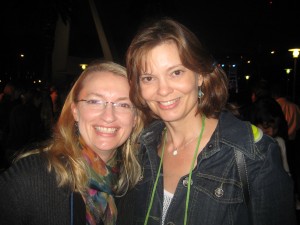
who used to work with DELTA, and of course, other friends from other institutions as well as my NC State Colleagues. Kind of affirming that I know of so many gifted and dedicated educators that are working hard to make a difference in higher education.
Friday, October 15
Presentation day! Up bright and early, grabbing a quick breakfast at 6:30am, meeting my fellow presenters (Alan, Bethany, Greg & Martin) at 7:45 in our designated meeting room for our 8am presentation! We were very surprised to find that the room quickly filled up, with people even standing to listen in (guess we are not the only ones struggling with how to govern things). I felt that we did a really good job of telling the story of our LMS governance model, and I’m pleased that we can share our work with others. We received a great response and lots of good questions.
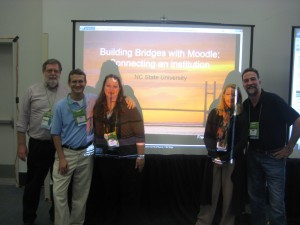
With our presentation ended my Educause experience, as it was time to go back to the hotel, pack, check-out and catch the shuttles & plane(s) that would get us back to WolfPack Country! I finished this post on the plane headed home – so a productive trip, all round.
Reflections from my Colleagues
In addition to writing a bit about my own experiences here, I have asked my colleagues if they could contribute some of their own reflections as part of this post regarding best ideas, best sessions, and key takeaways – or perhaps link to any other blog/feed that they created about the conference – you might find a few of these in the comments below.
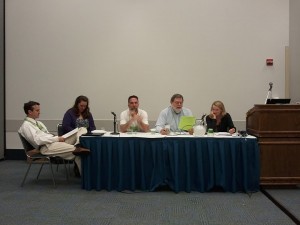

- Categories:


